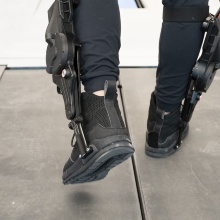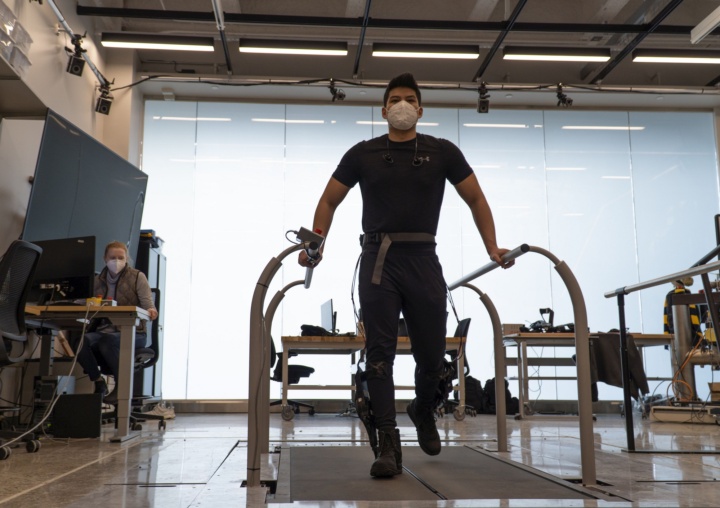Robotic exoskeletons support the movements of the persons wearing them and, for example, help impaired users to regain mobility. For the optimal cooperation between man and machine, complex adjustments are required so that the exoskeleton can provide the best possible level of support. In a collaboration between the University of Michigan and the University of Stuttgart, researchers have now demonstrated a method by which the users themselves can adjust the behavior of an ankle exoskeleton in less than two minutes. This puts the users in control and allows them to take into account their own preferences. The journal Science Robotics covered this in the issue from March 30, 2022.
Powered exoskeletons are usually not ready for immediate use but have to be adjusted by an expert, so that the different characteristics of the human body, the biomechanics of gait and the wearer’s preferences can be taken into account. Alternatively, this can be done by automatically evaluating quantifiable data such as metabolic rate or muscle activity in order to minimize energy consumption, for example. Or the wearer can be asked to repeatedly compare between different settings in order to find out which one is the most comfortable. However, the setting that leads to a minimum of energy consumption is not necessarily the most comfortable. Letting users choose between numerous settings takes time. Moreover, it does not reveal how the setting parameters interact with each other and affect the user experience.
The focus is on the user as a person
Therefore, Dr. Kim Ingraham and Prof. Elliot Rouse at the University of Michigan as well as Prof. David Remy from the Institute for Nonlinear Mechanics at the University of Stuttgart are focusing on subjective feedback instead of physiological measurements. They consider the users as the main focus of their research and give them the opportunity to directly change the setting parameters and to take into account preferences that are otherwise difficult to identify or measure. In this way, users can decide quickly and independently, which properties - such as comfort, performance, and stability - are most important for them and choose the setting accordingly, without the need for an expert to readjust. “The users’ ability to decide for themselves how it feels to be supported by an exoskeleton, will increase user satisfaction in the future and thus the acceptance of these devices,” says Kim Ingraham, “because no matter how helpful an exoskeleton might be: “If it’s not comfortable, people won’t wear it.”
In order to test the feasibility of the concept, the research team equipped users with ankle exoskeletons and a touchscreen and had them walk on a treadmill. The participants of the study were able to select different points on the touchscreen to change the behavior of the exoskeleton. Without knowing it, they were selecting the exoskeleton’s torque and timing values. These two parameters control what the support feels like.
Reliable data for individual adjustment
“Although we changed the mapping between the points on the touchscreen and the parameters with each repetition of the experiment, the participants always found their way back to their preferred, individual settings,” says David Remy. “This shows how important individual adjustments are and that users can provide us with very reliable data for this purpose.” The researchers were also surprised at how quickly the users were finding their preferred settings: Even people who had no previous experience with an exoskeleton managed to do so in an average of one minute and 45 seconds - without knowing which parameters they were setting. In addition, preferences changed in the course of the experiment: Users who already have experience with an exoskeleton prefer a significantly higher level of support than users who wear an exoskeleton for the first time.
The researchers want to fundamentally explore how user preferences can be included in the control of exoskeletons. In the next step, they want to find out why users prefer what they prefer, how these preferences affect their energy consumption, muscle activity, and physiology, and how a preference-based control could be automatically implemented in practice.
The collaboration between the University of Michigan and the University of Stuttgart was funded by the Carl Zeiss Foundation within the GSO/CZS return program for scientists, which the foundation established in cooperation with the German Scholar Organization. The program supports universities in filling professorships with German scientists from abroad.
Research on biomedical systems at the University of Stuttgart
Expert Contact:
Prof. Dr. C. David Remy, University of Stuttgart, Institute for Nonlinear Mechanics, phone: +49 711 685-60914, E-Mail
Original publication:
K. A. Ingraham, C. D. Remy, E. J. Rouse: The role of user preference in the customized control of robotic exoskeletons. Science Robotics 30. März 2022, DOI: 10.1126/scirobotics.abj3487




